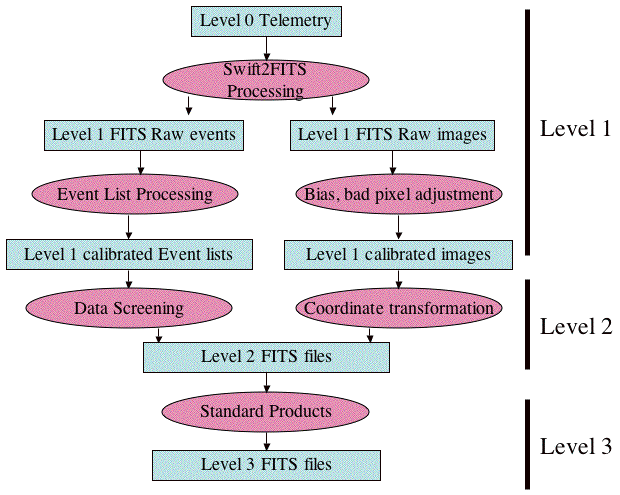- Home
- About
- Support
- Data Access
- Data Analysis
- Data Products
- Publications
-
Links
Databases NED Simbad GCN circulars archive GRB data table Software & Tools Swift Software (HEASoft) Xanadu WebPIMMS Institutional Swift Sites GSFC PSU OAB SSDC MSSL University of Leicester
Thread about files and the directory structure
The pipeline processing of the Swift Data is performed at the Swift Data Center (SDC) at the Goddard Space Flight Center (GSFC). Data received from the spacecraft, via telemetry dumps to the ground station - Level 0 files - are used to create FITS files containing image and event data from from the 3 instruments. These files are then sent through the pipeline, which leads to the formation of calibrated images and cleaned event lists.
The image below shows a flow diagram indicating the different levels of Swift data processing. The raw telemetry is converted to Level 1 FITS files, which then undergo a small amount of processing. Level 2 calibrated event lists and sky images are produced after data screening and coordinate transformation.

We recommend starting with the Level 1 files and running the processing by hand, as described in the xrtpipeline thread, to ensure the most up-to-date calibration has been used.
File naming convention
Data downloaded from the US Quick Look site will be automatically saved under a main directory with a name of the form sw[obsid].[segid]. For example, sw00374210000.008 would be a typical name for the master directory. If the data are obtained from the UK Quick Look site, then the name will be simply the Observation ID (00374210000 in the above example).
The version number - 008 in this example - indicates how many times the data have been through the pipeline. A brief overview of the Swift file naming convention is given here.
Level 1 eventlists are named sw[obsid]x<mode><window><type>_uf.evt, while level 2 files are sw[obsid]x<mode><window><type>_cl.evt. Here, <mode> will be wt or pc - i.e., Windowed Timing or Photon Counting; <window> - w1-w4 and <type> - sl, st or po, meaning slew, settling or pointing. Information about the different window sizes can be found in the software guide.).
